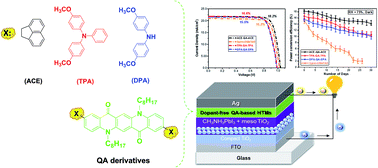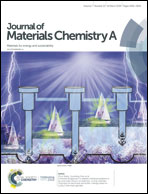Dopant-free novel hole-transporting materials based on quinacridone dye for high-performance and humidity-stable mesoporous perovskite solar cells†
Abstract
This study reports three newly developed dopant-free hole-transporting materials (HTMs) for perovskite solar cells. The design is based on a quinacridone (QA) dye as the core with three different extended end-capping moieties, namely, acenaphthylene (ACE), triphenylamine (TPA) and diphenylamine (DPA), attached to the QA core. These HTMs were synthesized and used to successfully fabricate in mesoscopic TiO2/CH3NH3PbI3/HTM perovskite devices. Under AM 1.5G illumination at 100 mW cm−2, the devices achieved a maximum efficiency of 18.2% for ACE-QA-ACE, 16.6% for TPA-QA-TPA and 15.5% for DPA-QA-DPA without any additives, whereas reference devices with doped spiro-OMeTAD as the HTM achieved a PCE of 15.2%. Notably, the unencapsulated devices based on the novel dopant-free HTMs exhibited impressive stability in comparison with the devices based on doped spiro-OMeTAD under a relative humidity of 75% for 30 days. These linear symmetrical HTMs pave the way to a new class of organic hole-transporting materials for cost-efficient and large-area applications of printed perovskite solar cells.

- This article is part of the themed collection: Research presented at the International Conference on Emerging Advanced Nanomaterials (ICEAN) 2018


 Please wait while we load your content...
Please wait while we load your content...